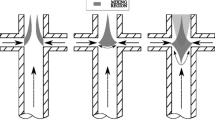Abstract
The hydrodynamic control of buoyant nonpremixed flames is investigated by injecting high-momentum fluid through a central microjet. The resulting flame characteristics are mapped for jets of different strengths. The flame height decreases linearly with an increase in the microjet Froude number as the flow changes from a buoyancy-dominated to a momentum-controlled regime. The flame luminosity is reduced by injecting stronger microjets. The jets alter the flame structure by establishing strong entrainment of the ambient air from the quiescent surroundings. The introduction of an inert species as the microjet fluid has a similar qualitative effect as air. Microjet assistance is as effective as partial premixing for reducing the flame height and luminosity.










Similar content being viewed by others
References
Alder BJ, Tseng LK, Laurendeau NM, Gore JP (2000) Combust Sci Technol 152:167–178
Baker J, Calvert ME, Murphy DW (2002) Structure and dynamics of laminar jet micro-slot diffusion flames. J Heat Transfer 124:783–790
Ban H, Venkatesh S, Saito K (1994) Convection-diffusion controlled laminar micro flames. J Heat Transfer 116:954–959
Becker H, Yamazaki S (1978) Entrainment, momentum flux and temperature in vertical free turbulent diffusion flames. Combust Flame 33:123–149
Becker HA, Liang D, Downey CI (1981) Effect of burner orientation and ambient airflow on geometry of turbulent free diffusion flames. Proc Combust Inst 18:1061–1071
Burke SP, Schumann TWE (1928) Diffusion flames. Ind Eng Chem 20:998–1004
Goldstein Jr L, Fassani FL, Santos AÁB (2002) Experimental study of secondary air diffusion effects on soot concentration along a partially premixed acetylene/ air flame. Int Commun Heat Mass Transfer 29:223–231
Hamins A, Yang JC, Kashiwagi T (1992) An experimental investigation of the pulsation frequency of flames. Proc Combust Inst 24:1695–1702
Heskestad G (1999) Turbulent jet diffusion flames: consolidation of flame height data. Combust Flame 118:51–60
Kaplan CR, Kailasanath K (2001) Flow-field effects on soot formation in normal and inverse methane–air diffusion flames. Combust Flame 124:275–294
Kheireddine AS, Chaturvedi SK, Mohieldin TO (1999) Computation of flame base height of a turbulent diffusion flame resulting from a methane jet. Int J JSME B 42:78–90
Kimura I (1965) Stability of laminar jet flames. Proc Combust Inst 10:1295–1300
Leahey DM, Preston K, Strosher M (2001) Theoretical and observational assessments of flare efficiencies. J Air Waste Mngmt Assoc 51:1610–1616
Lee BJ, Chung SH (2001) Characteristic of reattachment and blowout of laminar lifted flames in partially premixed propane jets. Combust Flame 127:2194–2204
Li SC, Gordon AS, Williams FA (1995) A simplified method for the computation of Burke–Schumann flames in infinite flame atmosphere. Combust Sci Technol 104:75–91
Lock AJ, Ganguly R, Puri IK, Aggarwal SK, Hegde U (2003) Gravity effects on partially premixed flames. In: Proceeding of the 3rd Joint Meeting, US Section of The Combustion Institute, Chicago, USA, 16–19 March 2003. The Central States Section of The Combustion Institute, Pittsburgh, PA
Mitchell RE, Sarofim AF, Clomburg LA (1980) Experimental and numerical investigation of confined laminar diffusion flames. Combust Flame 37:227–244
Mitrovic A, Lee T-W (1998). Soot formation characteristics of laminar partially premixed flames. Combust Flame 115:437–442
Ohisa H, Kimura I, Horisawa H (1999) Control of soot emission of a turbulent diffusion flame by DC or AC corona discharge. Combust Flame 116:653–661
Ratti S (1999) An experimental study on the structure of triple flames stabilized on a slot burner. MS Thesis, University of Illinois at Chicago
Roper FG (1977) The prediction of laminar jet diffusion sizes: Part I. Theoretical model. Combust Flame 29:219–226
Roper FG, Smith C, Cuningham AC (1977) The prediction of laminar jet diffusion flame sizes: Part II. Experimental verification. Combust Flame 29:227–234
Saito M, Arai T, Arai M (1999) Control of soot emitted from acetylene diffusion flames by applying electric field. Combust Flame 119:356–366
Saito M, Sato M, Nishimura A (1998) Soot suppression by acoustic oscillated combustion. Fuel 77:973–978
Saito M, Sato M, Sawada K (1997) Variation of flame shape and soot emission by applying electric field. J. Electrostatics 39:305–311
Sinha A, Ganguly R, Puri IK (2003) Optimization of a microjet controlled nonpremixed flame. In: Proceeding of the 3rd Joint Meeting, US Section of The Combustion Institute, Chicago, USA, 16–19 March 2003. The Central States Section of The Combustion Institute, Pittsburgh, PA
Acknowledgement
This research was supported partly by the National Science Foundation Combustion and Plasma Systems Program through Grant No. CTS–9707000 for which Dr. Farley Fisher is the Program Director, and partly by the NASA Microgravity Research Division through Grant No. NCC3–688 for which Dr. Uday Hegde serves as the technical monitor.
Author information
Authors and Affiliations
Corresponding author
Rights and permissions
About this article
Cite this article
Ganguly, R., Puri, I.K. Nonpremixed flame control with microjets. Exp Fluids 36, 635–641 (2004). https://doi.org/10.1007/s00348-003-0749-z
Received:
Accepted:
Published:
Issue Date:
DOI: https://doi.org/10.1007/s00348-003-0749-z




